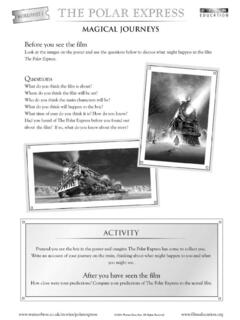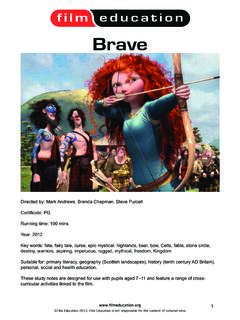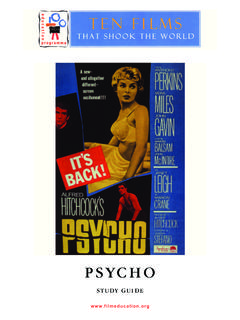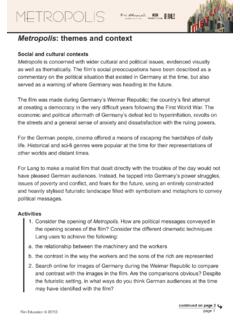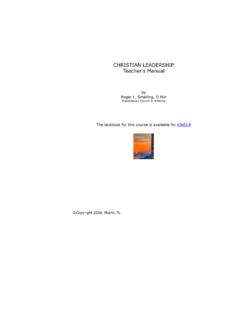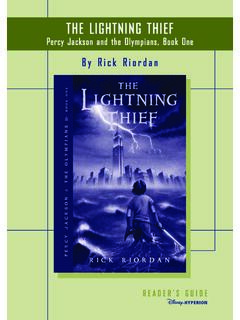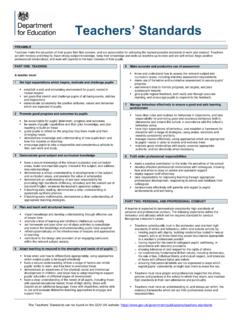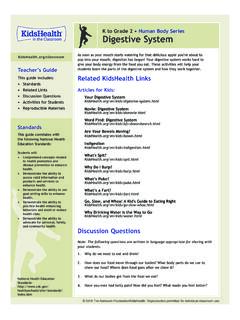Transcription of Teachers’ Notes - Film Education
1 Teachers NotesThis study guide examines Peter Weir s film The Truman Show released on October 9, 1998. It is aimed atstudents of GCSE, A Level, Scottish Standard, Scottish Higher and GNVQ Media Studies and covered in this study guide and the accompanying BBC Learning Zone television programme focuson representation and reality, forms and conventions within the film world, the popularity of docu-soaps andissues they raise and their place and effect within the media Burbank has the feeling that he s being watched. He doesn t know how right he is. Every second ofevery day, from the moment he was born, for the last thirty years, Truman Burbank has been the unwittingstar of the longest running, most popular documentary soap -opera in history. The picture perfect town ofSeahaven that he calls home is actually a gigantic soundstage. Truman s friends and family - everyone hemeets, in fact - are actors.
2 He lives every moment under the unblinking gaze of thousands of hiddentelevision cameras. Welcome to The Truman Show . The whole world is TRUMAN showDirector Peter WeirCertificate PGRunning time 103 minsE-mail: The Truman Show is a film which charts the life of Truman Burbank, a boy adopted at birth by a fictitioustelevision company - Omnicom. He is filmed twenty-four hours a day, seven days a week, three hundred andsixty-five days a year so every second of his life is recorded for live television. Truman doesn t know this. Hedoesn t know that his friends and family are all actors. He doesn t know that the events in his life are allcarefully monitored and controlled by the production crew of the television network. He doesn t know he is thestar of a television show nor that he isn t living in the real far as we know, the concept of this film is not yet a reality, as Peter Weir, the director, commented that hethought of the film as taking place twenty years or so in the , in the search for new scheduling ideas and greater audience figures, television networks becomeincreasingly involved in filming the lives of ordinary people as television entertainment.
3 Having read this do you want to see the film? What is it particularly that interests you? Do you agree with the concept of The Truman Show ? What moral and ethical problems do you see withmaking a programme of this nature? What practical problems might there be? Do you think it might happen? Why/why not?The DocumentaryRecent television documentary programmes have continued a long tradition of attempting to show real life indocumentaries. This generates debate about the responsibility of filmmakers and the representation of the history of the moving image audiences have been fascinated by the idea of film depicting thereal lives of other people at work or in the home. One of the earliest documentaries, Nanook of the North byFlaherty (1921), depicted Eskimo life with the help of local participants. Owing to the constraints of the hand-held camera, insensitive film stock requiring artificial light, and appalling weather conditions, Flaherty had toask his subjects to do their normal activities in special ways and at special times.
4 Because the Eskimos knewthat Flaherty was helping them to place on record a vanishing way of life they provided and influenced thecontents. The events of this film were manipulated, and the film was a huge success with audiences whowere keen to find out about the minutiae of other peoples those early days of documentary film-making, techniques and styles have evolved along with theintroduction of new technology, such as smaller and more sophisticated cameras and sound equipment whichallow the subjects to be less aware of the film-making process. The Truman Show is supposedly made withthe help of 5,000 cameras controlled by Christof the mastermind, creator, producer and director. Christof,from his mammoth control room, is the godlike figure who monitors, manoeuvres and manipulates Truman control of the production of the television documentary and the effect on the audience is central to thedebate about the responsibility of programme-makers.
5 According to Michael Rabiger in his book Directing theDocumentary (published by Focal Press, 1992) there are three types of 11. Those produced to give a definite message to the audience and therefore only give a one-sided view of thesubject. These programmes are usually produced by an advertiser or a political Both sides of a story are given equal coverage in the telling of a story to an audience that needs to beeducated and Programmes made to show the complexities of human life whereby the audience is engaged in makingdifficult judgements about the programme-makers quest for truth in portraying a real life idea of Truman being an unwitting subject of the television programme has some parallels with theproduction of the television documentary made in 1963 called 7Up . The programme took as its inspirationthe Jesuit saying, Give me a child until he is seven and I ll show you a programme-makers took fourteen children from a cross-section of society and filmed them at seven-yearintervals with the objective of finding out the extent to which a child s future is determined by their social most recent of these programmes was broadcast this year.
6 42Up intercut footage from previousprogrammes alongside recent interviews with the participants. Several of the original participants are nolonger involved in the programme, with one member leaving in 1990 making the following statement: I havehad enough of being used for small screen images of myself and of the other childrenhave been simplified to the point where they have become false. Please don t think the programmes tell youanything about me. If you want the truth turn off the television and come to Liverpool. In a similar way toTruman Burbank, these participants who co-operated with the programme-makers were only children in thebeginning and had no idea of the dramatic affect their participation, at seven-year intervals, would have ontheir lives. As adults they are now concerned that representations of them shown by the programmes is recent glut of television documentary soaps such as, Hotel - The Adelphi , Driving School , The Cruise , Airport and many others have put the spotlight on many areas of life, making the woman/man on the street the celebrity.
7 The programme about the Hotel Adelphi and the learner driver saw real people becomingcelebrities through television programmes combine elements of soap operas as storylines with the characters being followed fromone week to the next. There are elements of documentary-style television as the camera follows the subjectin a seemingly unobtrusive way allowing them to behave in a naturalistic manner. This genre is relativelycheap television depicting real people, not actors and actresses who will need to be paid. They are alsoextremely popular and therefore guarantee high audience ratings and advertising 2 Which of the three definitions shown applies to The Truman Show ? Explain how you hove come tothis that you had been involved in the making of a television programme like 7Up . How have youchanged since you were seven in terms of your looks, behaviour and opinions?
8 To help you in this tasklook at photographs of yourself at seven-year intervals. Ask parents and guardians about what you werelike at that age. If you knew you were to be filmed every seven years how might this affect what youchoose to do with your life, both in terms of your career and personal 3 Morality and EthicsThere are issues of human rights and ethics of programme-making which are at the heart of The TrumanShow with which the audience can identify. These are the same issues which are at the heart of representingany real people on television. Infringement of the rights of the individual within these television programmesis a major the UK, the Broadcasting Standards Commission, is an independent body set up to protect the rights of theindividual and considers complaints of unfair treatment or unwarranted infringement of privacy whilemonitoring matters of taste and the annual review produced in 1997-8 the Broadcasting Standards Commission expressed concern aboutthe recent spate of docu-soaps and programmes made by viewers themselves.
9 1 997 was undoubtedly theyear of the documentary. Many are pretty light-hearted but from time to time they raise important issues worthwider discussion, not least, whether they are truthful. There is no doubt that many television viewers are keen to watch someone else s daily life story. Therefore,there can be little doubt that many who choose to take part are happy to be included. It is sometimes easy forbroadcasting professionals, for whom television is a daily experience, to forget that for many others contactwith the production process and appearance on the screen is a once-in-a-lifetime experience that they mightlive to regret. Do they always understand what they are getting into? Do they appreciate what the consequences might be? Have they given truly informed consent?In all television interviews or footage the participants are asked to complete a release form which gives theirconsent for the footage shot to be used in a programme.
10 These forms are legally binding and are completedto protect the programme-makers from any legal action that may arise. The footage is edited and whilst thesingle uncut shot of events might be as an unbiased record of events, as soon as two shots are put togetherthey could create a false impression. Every cut in a film makes a claim that two things are related in someway but in fact are not. The production of a one-hour documentary involves 30-40 hours of original filmingwhich means that a great deal is not shown. The decision to select what is shown and how it is edited is inthe hands of the the participants were aware of the broadcast use would they allow themselves to be filmed carrying outtheir daily activities? As mentioned before, a recent example of this is the second series of the extremelypopular BBC series Hotel . Britannia Hotels, the owners of the Adelphi Hotel in Liverpool, wanted editorialcontrol of what went into the series which was seen by the BBC to tip the balance of the programme frombeing an honest documentary to a corporate video for the hotel have the lives of people who have become celebrities by television exposure been affected both ina positive and a negative way?



